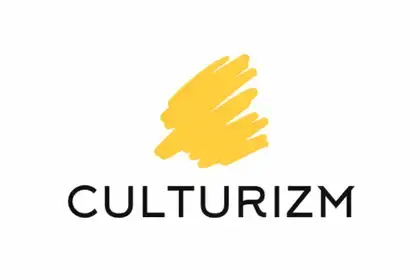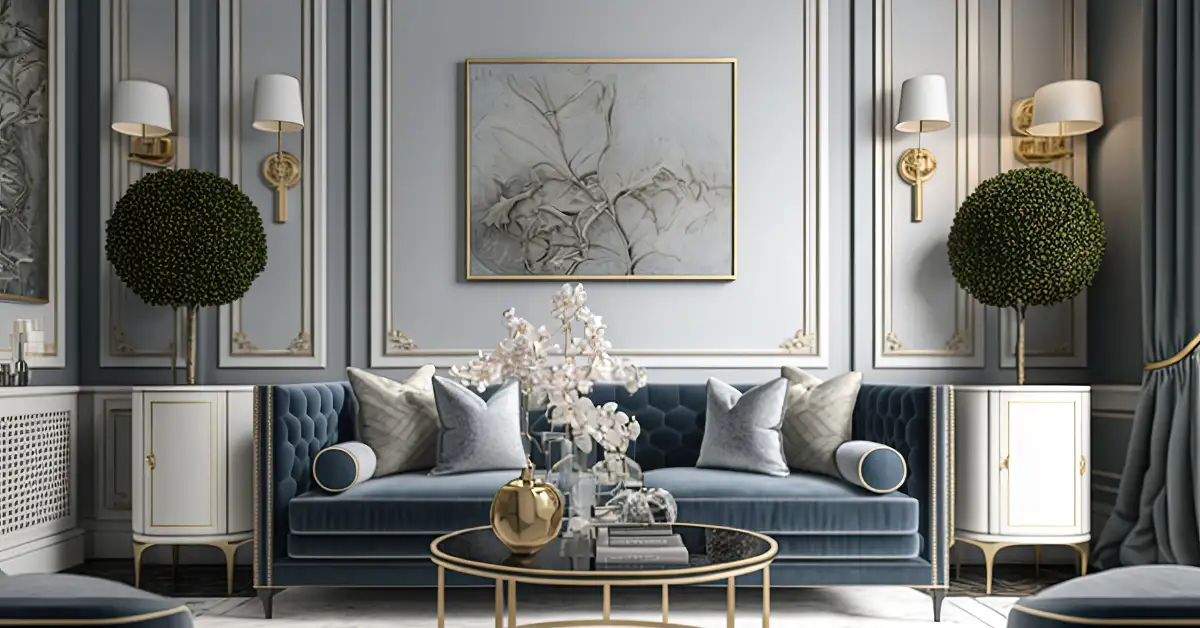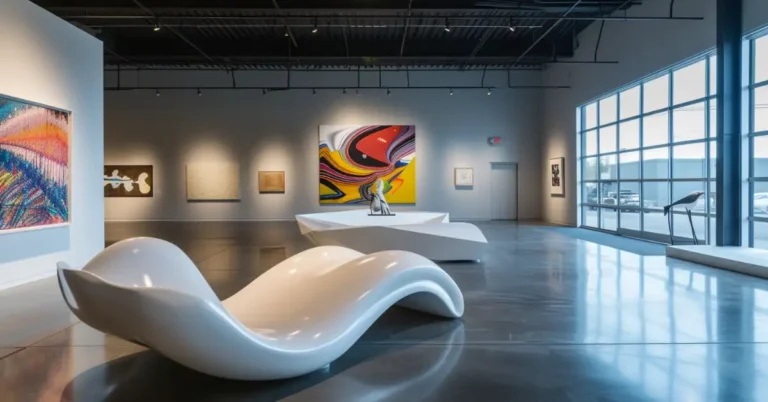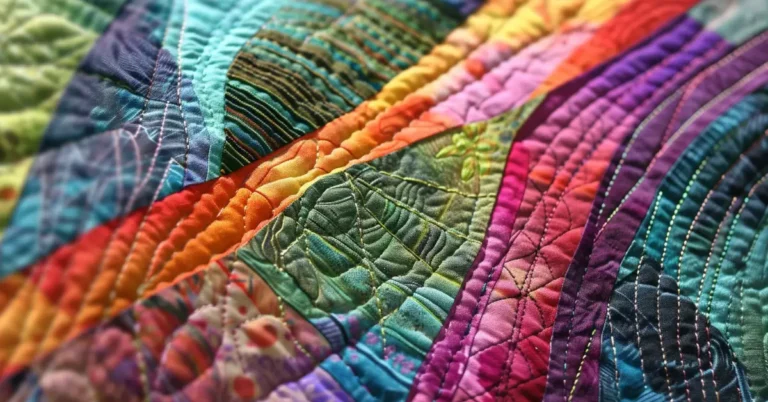Dive into the dazzling world of Contemporary Art Deco, where the glamour of the 1920s is reborn with a modern twist. Bold geometric patterns, luxurious colors, and sophisticated detailing blend the best of the past with today’s design innovation.
Pros:
✅Stunning visual impact with bright colors
✅High-quality materials ensure durability
✅Versatile decoration for various rooms
Cons:
❌Color discrepancies due to monitor differences
Contemporary Art Deco
Contemporary Art Deco Ideas
1. Streamlined Furniture Design

I absolutely love how streamlined furniture brings together sleek, smooth lines with minimal decoration.
This style screams contemporary while giving a nod to the luxury of Art Deco’s past.
- Opt for furniture with smooth, curving forms that suggest motion and flow.
- Choose pieces with shiny finishes like lacquer to catch the eye and add a touch of class.
- Look for subtle metallic accents, they’re perfect for that hint of glam.
- Stick with simple geometric shapes for a clean, organized feel in your space.
I’m telling you, there’s nothing like incorporating these elegant pieces into your home to make it look super chic and modern!
2. Chrome and Glass Accents

I love how chrome and glass accents can instantly elevate a room’s look!
Picture this: shiny chrome outlining sleek glass furniture—it’s like adding a sparkle to your space.
My Art Deco inspiration often pulls me towards coffee tables and side tables with gleaming chrome legs and glass tops. They’re so chic and perfect for bringing in that Art Deco elegance with a modern twist.
I’ve also seen this combination work wonders with lamps and mirrors.
There’s something about the reflection of light on glass and metal that provides an aura of luxury and timeless style.
Mixing these materials creates a focal point that catches the eye and adds a layer of sophistication to any room.
3. Velvet Upholstery

I simply adore the lush feel of velvet upholstery! It’s a central feature in Art Deco design, bringing a sense of luxury and comfort to any living room.
Imagine sinking into a sofa with velvet fabric — it’s the perfect blend of opulence and plushness.
And the colors! Deep blues, rich purples, and bold emeralds are just some of the hues that can transform a space.
Beyond looks, velvet is also quite durable, making it a practical choice for homes.
It’s amazing how this fabric combines sumptuous texture with long-lasting quality.
4. Marble Tables

I’m thrilled to talk about marble tables, especially when they infuse that luxurious Art Deco vibe into a space.
Imagine the sleek, cool touch of marble under your fingertips.
These tables aren’t just furniture; they’re statement pieces that scream elegance and sophistication.
I’ve seen these amazing modern marble dining table design ideas and let me tell you, they can really transform a room.
Whether it’s a bold black marble with striking white veins or a softer white marble that brightens up the room, each piece feels like a work of art.
My favorite is pairing these tables with plush, velvet chairs – the texture contrast is absolutely divine. Let’s not be shy about it; marble tables are the gems of interior design right now!
5. Gatsby-Inspired Lighting

I’m thrilled to shed some light on Gatsby-inspired lighting, which is a central feature in Art Deco design!
Imagine you’re stepping into a scene from “The Great Gatsby,” where the mood is set with opulent lighting that showcases modernity and luxury.
- First, geometric patterns are a must. Pieces that incorporate sharp angles and clean lines can transform any space.
- Don’t forget the glitz; chandeliers with crystals capture that high-society elegance.
- For a touch of drama, tiered lighting options can cascade light beautifully through a room.
I love how Art Deco interior design emphasizes luxury, and with these lighting tips, my place can feel just as lavish!
6. Chevron Area Rugs

I just love how chevron area rugs can instantly jazz up a room!
There’s something about the bold zigzag patterns that brings in a dash of excitement.
In my quest for the perfect Art Deco touch, I found that these rugs come in various colors and materials.
Imagine walking into a room and your eyes being greeted by a stunning Art Deco Chevron and Zigzag Rug, its pattern making a striking statement!
It’s not just about looks, though; many are durable and resist stains, so they’re practical too.
My favorite thing is how these chevron patterns don’t just complement Art Deco—they fit right into modern decor, too!
They can be the centerpiece of a living room or a subtle accent in a bedroom. Every time I see one, it’s like a little party for the eyes!
7. Mirrored Furniture

I just adore mirrored furniture! It’s such a chic way to bring a touch of glamour into any room.
The reflective surfaces can make smaller spaces look bigger by bouncing light around the room.
I found some awesome contemporary mirrored furniture that could lift any room’s aesthetic.
Imagine a mirrored coffee table as a centerpiece or a gorgeous nightstand that adds a dash of elegance to the bedroom.
These pieces are not just furniture; they’re like functional art that instantly upgrades the space.
I’m thrilled at how they can blend with other Art Deco elements for that perfect balance of modern and vintage charm! Isn’t it exciting to think how a single piece can transform the entire look and feel of a room?
8. Black and Gold Color Schemes

I’m thrilled to share one of my favorite color pairings in contemporary Art Deco design: black and gold.
This duo is timeless and exudes a sense of luxury that can transform any room into an elegant space.
When I use black in a room, it creates a bold backdrop that makes everything else shine, especially when gold enters the picture.
Gold adds that touch of opulence and glamour, catching the eye with its shimmer.
I adore how versatile this combination is.
It’s about balance and letting each color bring out the best in the other.
I find that gold accents, like cushions or artwork, pop beautifully against a dark wall.
It’s a pairing that truly makes my design heart race with excitement!
9. Vintage-inspired Posters

I absolutely love how vintage-inspired posters bring a touch of the past into the present!
These posters, with their bold colors and striking geometric shapes, capture the essence of the Art Deco era.
They’re perfect for adding a dash of nostalgia and style to any room.
The best part is that you can find designs that incorporate elements from various times, like Mid-century Modern or Retro Futurism, making them incredibly versatile.
I’ve seen these posters act as stunning focal points in modern home decor, and I think they’re just fabulous for sparking conversation and igniting imagination.
10. Art Deco Fireplace Mantels

I’m thrilled to share one of my favorite elements in Art Deco design—fireplace mantels that stand out like a gem in any room!
These mantels grab attention with their bold geometric shapes and luxurious materials.
Imagine sleek lines combined with exotic woods and shimmering metals.
It’s like a step back into the roaring ‘20s, but with a modern twist that feels fresh and new.
Adding an Art Deco mantel to your living space instantly uplifts the ambiance, giving it that vintage glamour we all adore.
For more inspiration, I’ve found stunning designs that you can peek at, like this eye-catching Art Deco mantel that’s just begging to be the centerpiece of a home.
11. Bold Wall Art

I absolutely love the idea of incorporating bold wall art into an Art Deco bedroom!
It’s like giving your room a spark of personality and a burst of visual interest.
In the spirit of Art Deco, I suggest choosing pieces with strong geometric patterns or those that pop with color.
Imagine having a large, vibrant painting that captures the luxurious essence of the era—it’s a statement that guests won’t forget.
For a truly cohesive look, I’d consider metallic frames that tie in with Art Deco’s metallic accents.
Think gold or silver, which can add that extra touch of opulence.
Remember, choose art that speaks to you; it’s not just decor, it’s a conversation starter!
12. Use of Lacquer

I just love how lacquer adds that shiny, polished look to any room!
It’s like giving your space a high-gloss finish that totally transforms it.
Lacquer isn’t just about good looks, though; it’s durable and protects surfaces too.
But you know what I find really amazing? The bright and bold colors lacquer brings into a room.
This isn’t just a subtle shine; it’s a statement!
Using lacquer in a contemporary Art Deco space means embracing that classic glamour and making it totally modern.
I’m telling you, it’s an absolute game-changer for creating that 1920s elegance with a 21st-century twist.
13. Sculptural Light Fixtures

I’m thrilled to share one of the most dynamic trends sweeping through the world of interior design – sculptural light fixtures!
These are no ordinary lights; they are statement pieces that truly captivate the attention of anyone who walks into the room.
Imagine mid-century opaline glass pendant lights bringing a retro flair to your living space, or a steel wire mesh sculptural pendant adding an industrial yet sophisticated touch.
What I love about these sculptural ceiling lights is that they are not just sources of light; they are works of art that enhance the overall aesthetic of your home.
They bring an artistic touch that excites the senses and adds elegance to any space.
Whether hanging proudly in your entrance hall or casting a warm glow in your dining area, these lights elevate the ambiance to a whole new level of artistry.
Historical Context
Emerging from the vibrant cultural milieu of early 20th century France, Art Deco transformed the aesthetic landscape, extending its influence far across the Atlantic to the burgeoning skylines of America.
Contemporary Art Deco is a modern revival of the classic Art Deco style, known for its bold geometric patterns, rich colors, and ornate detailing, blending vintage charm with modern design sensibilities.
Art Deco Origins
Art Deco, a term derived from the Exposition Internationale des Arts Décoratifs et Industriels Modernes, held in Paris in 1925, reflected the collective desire for a new expression of modernity and elegance. Its geometric symmetry and lavish detailing marked a departure from the curvilinear motifs of Art Nouveau.
Influential Movements
The movement drew inspiration from various styles and disciplines, including the bold geometric patterns of Cubism, and the burgeoning machine-age advancements. Together, these influences synthesized into a distinctive style that championed progress and luxury.
Is Art Deco in Style Today?
Even today, Contemporary Art Deco’s legacy endures in numerous public buildings and monuments. Cities like New York boast iconic landmarks such as the Chrysler Building and the Empire State Building, true testaments to the movement’s lasting appeal and its ability to embody the ethos of its time while remaining fashionable in the modern world.

IG: tarekalkhattab
What is the difference between Contemporary Art Deco and Art Nouveau?
When they explore Contemporary Art Deco, art enthusiasts delve into a world where modern aesthetics blend with industrial-influenced design elements. On the other hand, Art Nouveau is a celebration of natural forms, flowing curves, and organic motifs, seeming almost to stretch and grow before their eyes. The two movements, while historic in their origins, continue to spark interest and find new expressions in today’s art and design landscapes.
Art Deco:
- Focuses on symmetry and streamlined shapes
- Emulates the speed and dynamism of the modern age
- Utilizes bold geometrics and metallic finishes
Art Nouveau:
- Embraces asymmetry and natural, sinuous lines
- Draws inspiration from natural forms like plants and flowers
- Often features detailed, intricate patterns with soft and muted colors
Contemporary interpretations of Art Deco revel in the past’s glamour but with a sleek, modern twist. They infuse spaces and objects with opulence and order, while Art Nouveau touches offer a more emotional, intimate connection with nature and detail.
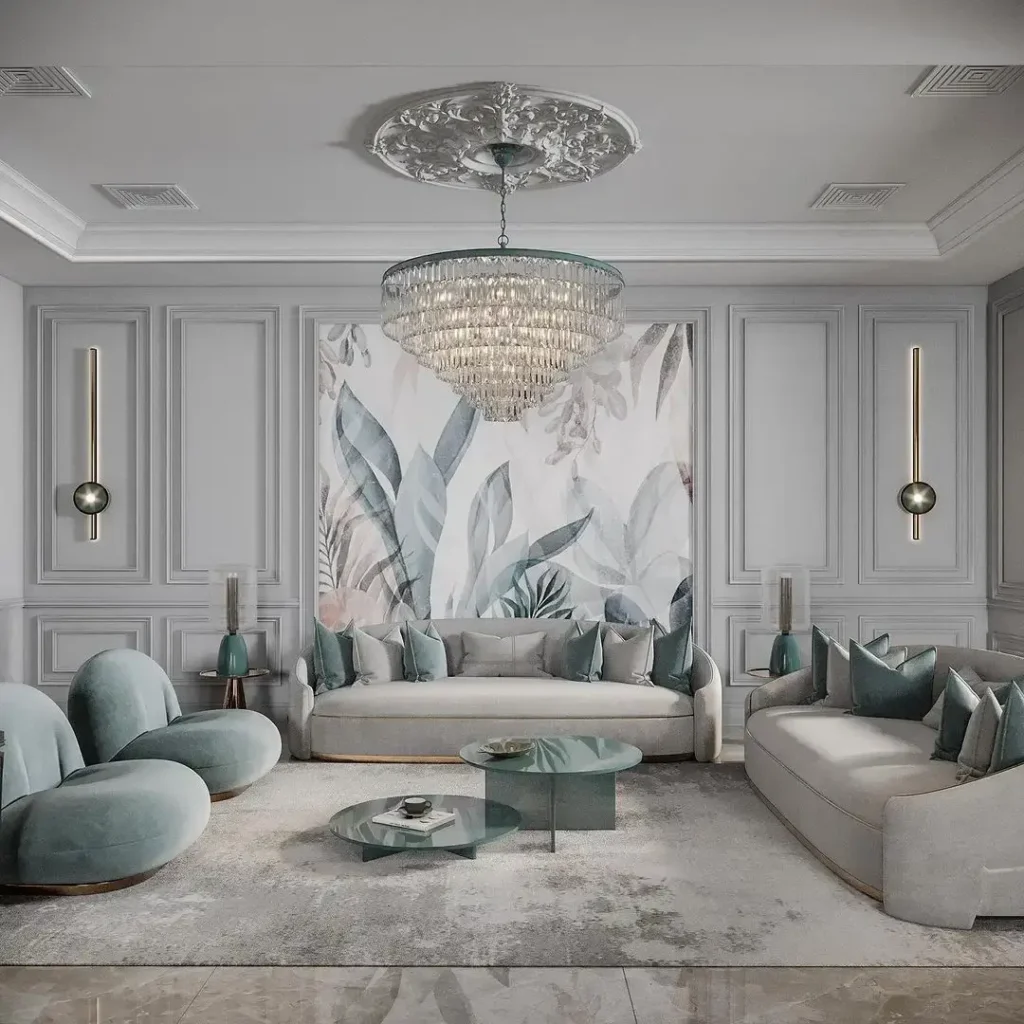
IG: tarekalkhattab
Design Elements
Capturing the essence of the Roaring Twenties and extending into the heart of the 1930s, Art Deco design encapsulates opulence with a touch of modernity. It is a visual celebration where functional forms meet lavish embellishments. Now, let’s explore the multifaceted design elements that define Art Deco’s enduring allure.
Defining Characteristics
Contemporary Art Deco is distinguished by its use of bold geometric forms, such as trapezoids and zigzags, and streamlined appearances. Symmetry and repetition play into the overall aesthetic, creating dynamic yet balanced compositions. This style moderne is marked by rich ornamentation and a characteristic streamlined appearance that speaks to a fascination with machinery and speed.
Materials and Textures
In Contemporary Art Deco design, luxurious materials like brass, gold, and chrome are commonplace, often accompanied by accents of velvet and other rich fabrics. The textures tend to vary, combining smooth, polished surfaces with softer, luscious upholstery, creating a tactile experience that is both opulent and sleek.
Color Schemes
The Art Deco palette is known for jewel tones like emerald and sapphire, alongside bold colors and creams. The color palettes are often paired with metallic accents, contributing to the sumptuous, high-contrast look that makes the style so distinctive.
Motifs and Patterns
Art Deco’s characteristic motifs range from sunbursts to chevrons and include geometric patterns inspired by both the natural and industrial worlds. The patterns are bold and often ornamented, with geometric shapes and zigzags creating a sense of movement and rhythm within the design.

IG: tarekalkhattab
Architectural Features
Iconic and lavish, Contemporary Art Deco architecture stands as a testament to the innovation and extravagance of its time. It is the embodiment of luxury and sophistication merged with the modernity of the early 20th century, equally captivating in its exterior form and interior grandeur.
Contemporary Art Deco in Architecture
A stroll around a city that flourished during the 1920s and ’30s often reveals the timeless charm of Art Deco architecture. Buildings like the famed The Chrysler Building epitomize this style through their use of sleek lines, geometric patterns, and symmetry. Skyscrapers not only reached new heights during the Contemporary Art Deco movement but also gained a sense of character with decorative elements that broke the mold of utilitarian design.
- Arches: Art Deco took simple arches and transformed them into elaborate decorative elements, often featuring intricate designs or flanked by sculptural forms
- Crown Molding: This decorative feature was given new vigor, with bold, streamlined forms that added a touch of elegance and formality to the buildings
- Stained Glass: Art Deco embraced the use of stained glass, not just for its color, but as a means to incorporate light and shadow into its design narrative
Building Interiors
The interiors of Contemporary Art Deco buildings were as meticulously designed as their exteriors. They were spaces where luxury and comfort met the modern age, often featuring materials like chrome, glass, and shiny fabrics—sometimes accented with exotic woods and artisan tile to create a bright and bold statement. The use of mirrors and reflective surfaces brought more light into rooms, and metallic trimmings and moldings underscored the Art Deco ethos of style and substance.
- Molding: Inside, decorators used moldings not just as a transition between walls and ceilings but as an opportunity to emphasize the Art Deco love for geometric shapes and motifs
- Symmetry: Art Deco interiors often hinged on symmetrical layouts, offering a sense of balance and rhythm to spaces
The harmonious synergy between function and art makes Art Deco interiors timeless, allowing them to withstand the passing of trends and remain eternally stylish.
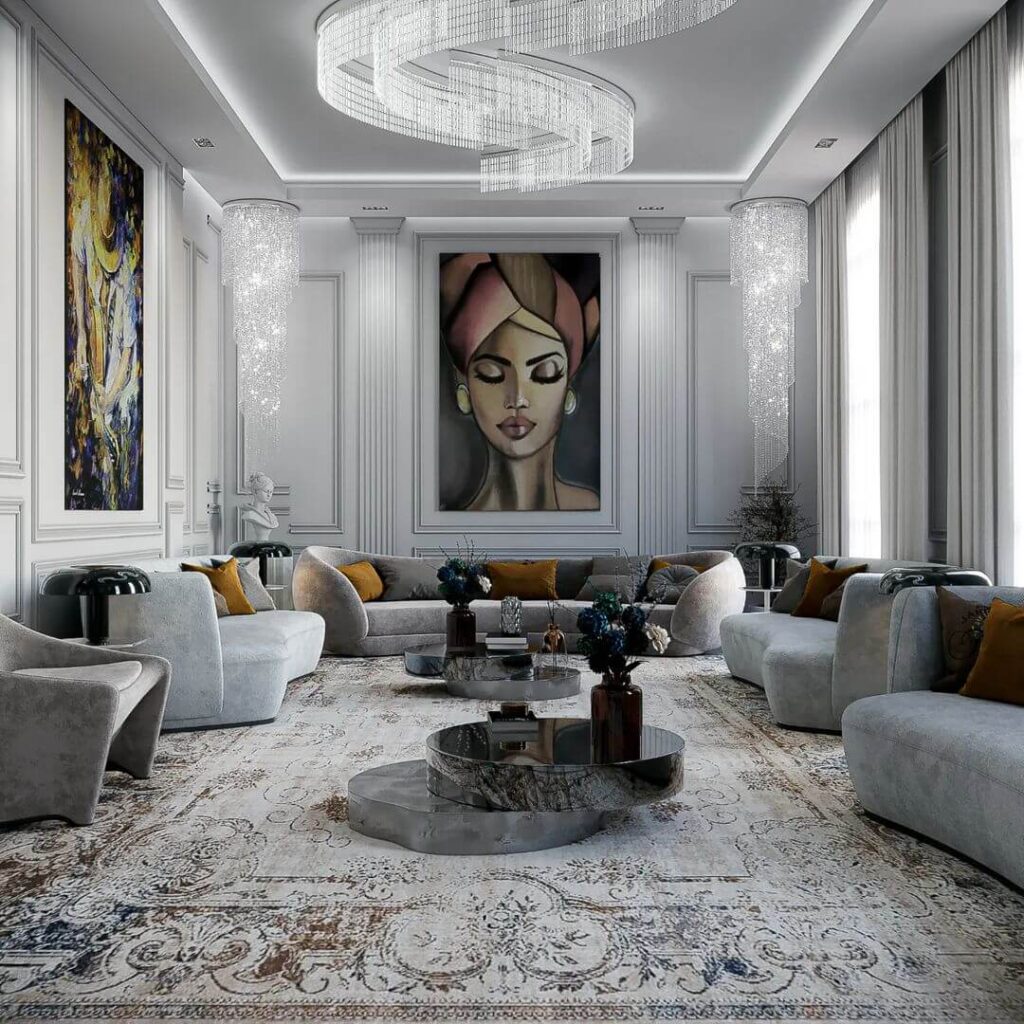
IG: tarekalkhattab
Furnishing and Decor
The resurgence of Art Deco in interior design marries vintage charm with modern flair. Enthusiasts can recognize Art Deco furniture by its streamlined forms and rich materials, with designers like Jacques Ruhlmann leading the charge. Lighting, pivotal in setting the Art Deco mood, often features geometric glass shades and shines a spotlight on the era’s penchant for glamour.
Contemporary Art Deco Furniture
Contemporary Art Deco furniture stands out with its geometric shapes and opulent detailing. Iconic figures like Émile-Jacques Ruhlmann were masters of combining luxurious materials such as ebony and exotic woods with bold, symmetrical designs. Expect to find items like:
- Sleek, high-gloss sidebars and cabinets
- Armchairs with plush, velvety fabrics and clean lines
- Cocktail tables with mirrored finishes or inlaid wood patterns
Lighting and Accessories
Lighting and accessories in the Art Deco era are more than utility objects; they are statement pieces. Chandeliers and sconces boasting angular designs and made with chrome or brass are typical, while:
- Table and floor lamps often feature frosted glass and stylized figures
- Mirrors and clocks incorporate sunburst or chevron motifs
Wall and Floor Design
Wall and floor designs reflect Art Deco’s love for lavish and functional aesthetics.
- Terrazzo floors create a mosaic of sophistication underfoot
- Wall coverings range from metallic wallpapers to bold, geometric patterns – each an homage to the era’s spirit and the vision of Art Deco artists like Jean Dunand
By embracing these distinct elements, one can transport a space back in time while maintaining a fresh, contemporary edge.
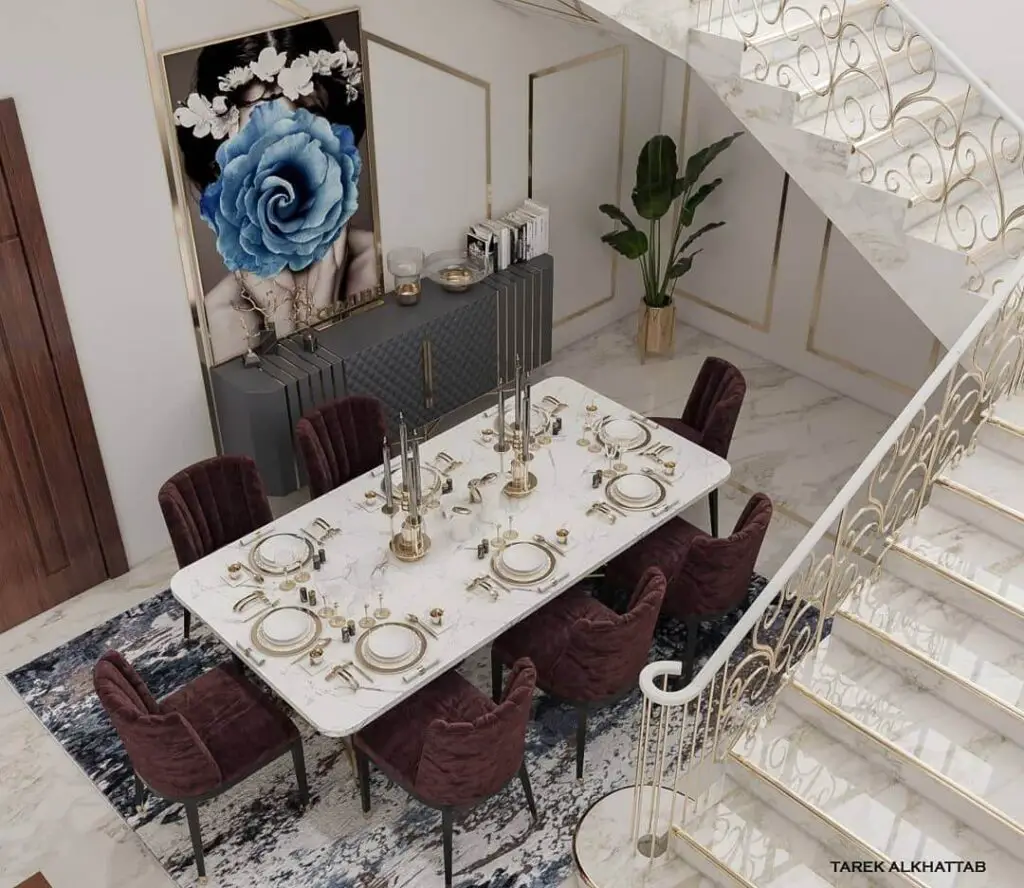
IG: tarekalkhattab
Prominent Artists and Architects
Within the shimmering world of Art Deco, certain names resonate with aesthetic innovation and architectural brilliance. At the movement’s zenith, Jean Dunand stood out, infusing modernity’s pulse into every piece he created. His mastery of lacquer and metalwork remains unparalleled, translating traditional craftsmanship into modern opulence. Jacques Ruhlmann—or Émile-Jacques Ruhlmann—was another maestro, a furniture designer whose pieces whispered the glamour and sophistication of the era through rich materials and elegant forms.
On the American architectural front, William Van Alen soared to fame with his iconic design of the Chrysler Building in New York City. With its glistening spire and terraced crown, the building exemplifies the fusion of form and function— a hallmark of Art Deco’s enduring legacy.
| Artist/Architect | Known for |
|---|---|
| Jean Dunand | Lacquer work, metalwork |
| Jacques Ruhlmann | Luxurious furniture, craftsmanship |
| William Van Alen | Chrysler Building, architectural innovation |
Art Deco sculpted an era where design crossed the threshold into the future without abandoning the elegance of the past. These trailblazers remain celebrated for shaping a timeless movement that dazzles to this day.
FAQ – Contemporary Art Deco
Can Art Deco be modern?
Yes, Art Deco can be modernized; contemporary interpretations often streamline traditional Art Deco elements for a more minimalist aesthetic.
What are the three styles of Art Deco?
The three styles of Art Deco are zigzag, classic moderne, and streamline modern.
What is Art Nouveau Deco?
Art Nouveau Deco is not a recognized art style. Instead, there are two distinct movements: Art Nouveau, with its organic, flowing forms, and Art Deco, known for its bold geometric shapes.
What are 4 features of Art Deco?
Art Deco is characterized by geometric shapes, sharp linear appearance, intricate line art, and metallic colors.
Please remember to share your thoughts in the comments section below if you enjoyed reading our blog post on “Contemporary Art Deco.” We’d love to hear about your experience!
If you want to keep reading more from us, have a look at these articles.
